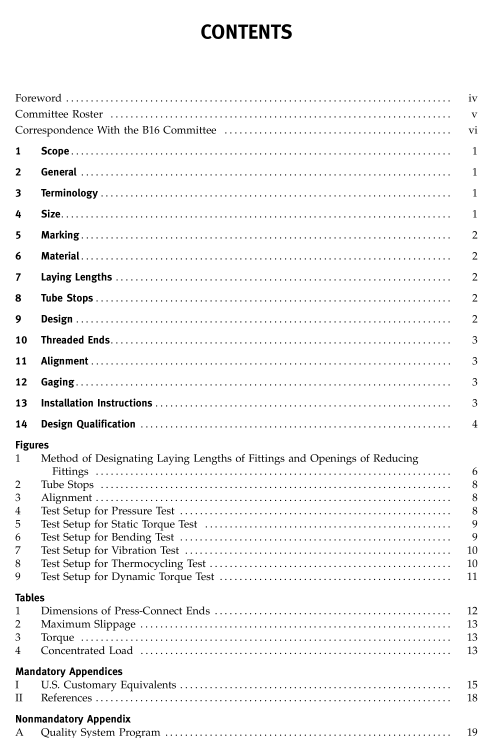ASME B16-51 pdf download

ASME B16-51 pdf download Copper and Copper Alloy Press-Connect Pressure Fittings
9.3 Inside Diameter of Fitting Theminimumcross-sectionalareaoftheinside diame- ter through the fitting body shall not be less than the theoretical minimum area defined by diameter O in Table 1 (Table I-1). The out-of-roundness condition of the cross-sectional area shall not exceed 10% of the mini- mum diameter shown in Table 1 (Table I-1). For reducer or adapter fittings, the smallest end diam- eter shall apply, provided that this diameter does not restrict the other outlets.
9.4 Wall Thickness The minimum wall thickness taken at any location of the fitting shall not be less than shown in Table 1 (Table I-1). 10 THREADED ENDS The threaded ends shall have right-hand nominal pipe taper (NPT) threads conforming to ANSI/ASME B1.20.1.
10.1 Countersink or Chamfer All internal threads shall be countersunk a distance no less than one-half the pitch of the thread, at an angle of approximately 45 deg with the axis of the thread. All external threads shall be chamfered at an angle of 30 deg to 45 deg from the axis. Countersinking and chamfering shall be concentric with the threads. The length of threads shall be measured to include the countersink or chamfer. 10.2 Threading Tolerances NPT threads shall be checked by use of a plug or ring gage in either standard or limit types. When gaging internal taper threads, the plug gage shall be screwed hand-tightinto the fitting. The reference pointfor gaging internal product-threads depends onthe chamferdiame- ter. When the internal chamfer diameter exceeds the major diameter ofthe internal thread, the reference point shall be the last thread scratch on the chamfer cone. Otherwise, when the internal chamfer diameter does not exceed the major diameter of the internal thread, the reference point shall be the end of the fitting. In gaging external taper threads, the ring gage shall be screwed hand-tight on the external thread. On the exter- nal thread, the ring gage shall be flush with the end of the thread. Tolerance foraninternal threaded end havinganinter- nal shoulder shall be from the gage reference point (notch) to one turn small. Tolerance for an internally threaded end without a shoulder, and for an externally threaded end, shall be from one turn small to one turn large.
10.3 Design of Threaded Ends The wrenching section of internally threaded ends shall be polygonal, and the wrenching section of exter- nally threaded ends shall be furnished with either polygon or flats, at the manufacturer’s option.
11 ALIGNMENT The maximum allowable deviation in the angular alignment of any end from the specified axis position shall be 1 ⁄ 2 deg (1 deg total). See Fig. 3.
12 GAGING
12.1 Preferred Gaging Method of Press-Joint Ends The preferred method of gaging the diameter toler- ances for external and internal ends shall be by the use of plain plug and ring gages designed to hold the product within the limits established in Table 1 (Table I-1). Gage tolerances shall be Class ZM, as defined in ASME B4.4M.
12.2 Optional Gaging Method of Press-Connect Pressure Fittings For gaging the diameter tolerance of external and internal ends, the use of direct reading instruments instead of ring and plug gages as specified in para. 12.1 shall be permitted. When gaging the diameters of exter- nal and internal ends using direct reading instruments, refer to para. 9.2.
12.3 Standard Gaging Method of Threaded Ends The standard method of gaging the externally and internally threaded ends shall be in accordance with the requirements of ANSI/ASME B1.20.1. NOTE: In gaging pipe threads, it is acceptable and common prac- tice to rap or tap the part to ensure proper seating of the gage. However, it is first necessary to cleanboth the gage and the product threads to ensure that they are free of chips, burrs, abrasives, or other foreign materials.
13 INSTALLATION INSTRUCTIONS The manufacturer of press connection fittings shall provide instructions for the installation of the fittings. The instructions shall provide a minimum of
(a) end preparation of the tube
(b) assembly of copper tube to the fitting (c) requirements for the tool used to form the press- connect joint (d) pressing procedure Installation instructions shall include details to enable assemblers to install fittings with performance consist- ent with that demonstrated by the design qualification testing described in section 14. The pressure–temperature ratings are only applicable to fittings thatare installed inaccordance withthe manu- facturer’s instructions.









